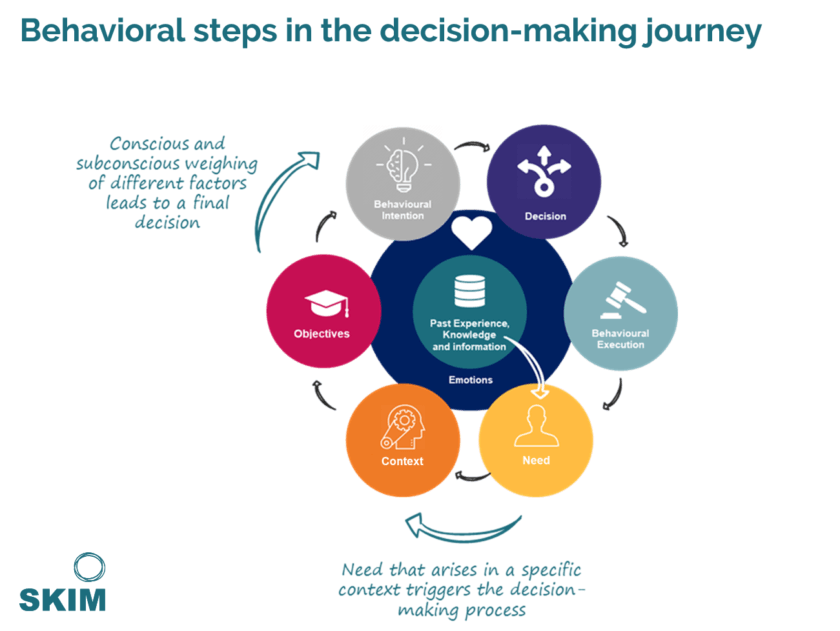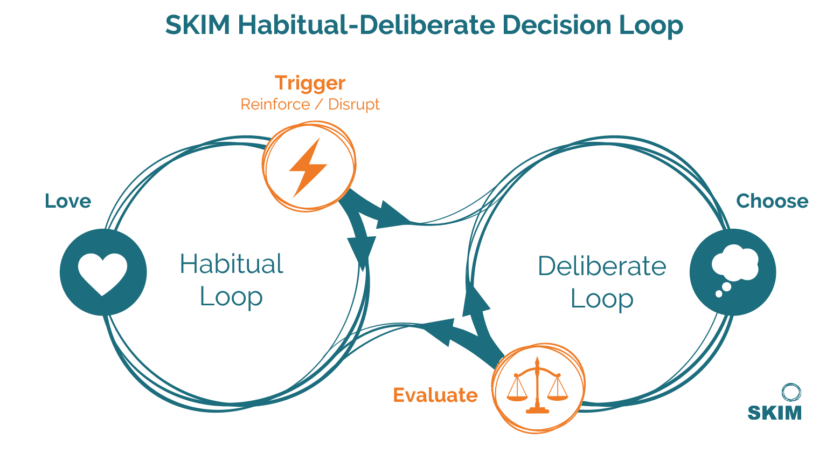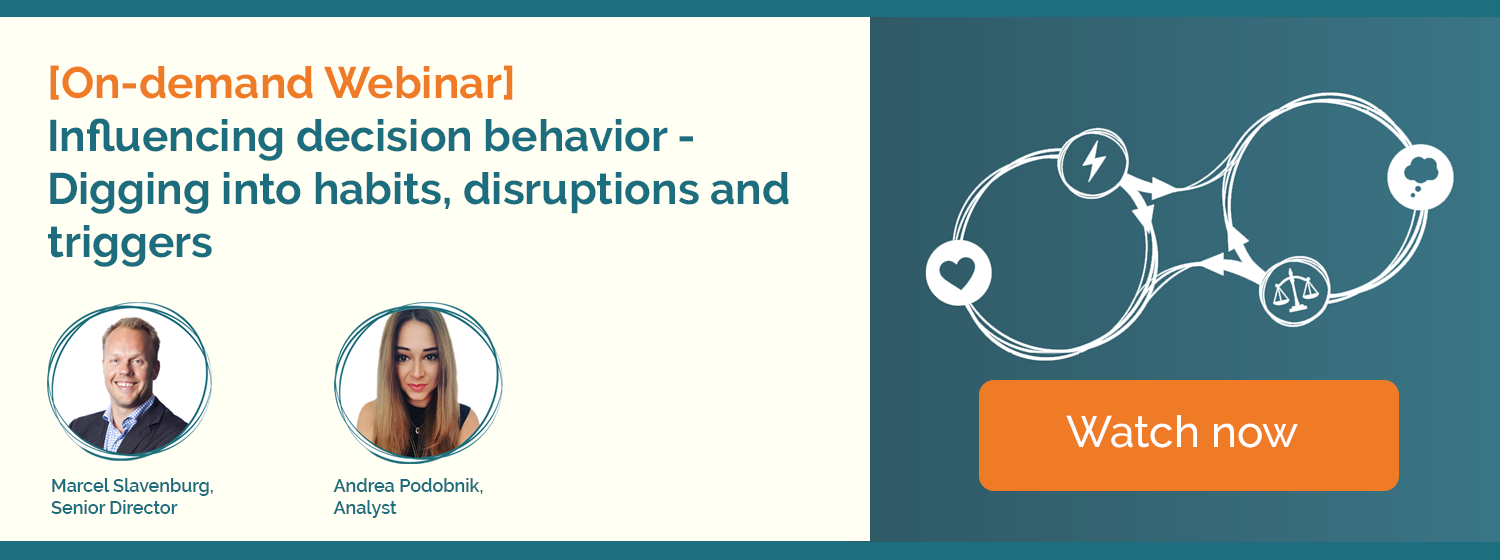Why do people choose one product or service over another? What needs or objectives are tapped into when you consider buying or recommending one brand over another?
Whether your brand targets consumers or professionals, understanding how decision behavior works and systematically applying its principles can help you build more effective strategies to drive customer acquisition, brand loyalty and continued growth.
We recommend you tap into “habitual” behavior to reinforce positive habits or break the ones that don’t benefit your brand and analyze “deliberate” behavior to assess how, where and when your brand can intervene.
Here we explain how decision-making works and the behavioral steps that are involved in making choices. Read on to learn how leveraging these insights to reinforce or disrupt habits can help your brand grow.
Decision behavior explained
To determine how and where your brand strategies can influence decision behavior, it’s important to dive into exactly how decisions are made.
Decision-making starts with a person recognizing that there is a need that needs to be satisfied (e.g. “I’m hungry”). If this need results in an objective (finding food), the individual will follow up by gathering information, identifying different options, and then weighing the pros and cons of each before finally making a (purchase) decision.

The above decision journey is simplified, because most of the time there are several needs (e.g. healthy food, within a 30-minute lunch break, easily available) that are considered and prioritized impacting the options and the ultimate decision.
Where should you “intervene” in this decision-making process if you want to affect the outcome? The good news is that brands can act at any stage to influence their customers.
The Habitual-Deliberate Decision Loop
Decision making can be either fast or slow. How quickly the decision is made depends on the size or weight of the decision and the context e.g. habitually buying milk (fast) vs. deliberating to buy a car (slow).
We like to think about fast and slow decision-making in terms of “habitual” (repetitive) behavior, or “deliberate” (considered) choices.
At SKIM, we work with major CPG, healthcare and B2B brands, helping them to understand how decisions are made and how behavior changes within their market and category. Using sophisticated research techniques, we provide robust and actionable insights to inform communications, revenue, innovation, and eCommerce strategies.
We use our Habitual-Deliberate Decision Loop to help guide clients in these strategies.
Brands should have clear strategies focused on both sides of the Habitual-Deliberate Decision Loop, each with its own approach and impact on driving company growth:
- If your customer’s habits work in your brand’s favor, you will want to keep these customers on the habitual side by reinforcing this behavior (e.g. to maintain brand loyalty). How can communications strategies help achieve this?
- Alternatively, if someone’s habits do not work in your favor, you might want to reach them by disrupting their habits, moving them into the deliberate loop and systematically winning them over (e.g. encouraging trials of alternative products or services). How can introducing new product features or services drive trials?
In fact, any business strategy can be translated back to the Habitual-Deliberate Decision Loop: where do we want our customers or prospects to be in the loop and which levers should we pull to help achieve that?
The key to making this happen is context; context determines whether a behavior will become habitual or not.
How brands can reinforce habitual behavior
A stable environment is crucial for habits to form. Without a trigger or disruption, people aren’t likely to consider alternative brands, products or services. People remain (more) habitual when brands reinforce a stronger connection between their customers’ goals and the love for the brand. Brands can help create this connection in a variety of ways and at different levels.
Communications and promotions strategies can be adapted to grab attention, loyalty programs can be initiated, advertising product benefits and features can be optimized, and emotions associated with the product, service or brand can be amplified.
What triggers deliberate decision making?
Habitual behaviors can be difficult to disrupt since they are not only “automatic,” but also goal-driven, related to satisfying an individual’s different needs and priorities.
To be able to interrupt these habits, brands need to understand what drives them at a rational and emotional level.
Change in context is key. In an altered context, habits can be broken. Normal decision cues will have changed or disappeared, so making a choice between options becomes more deliberate. In a disrupted context, your brand may have an equal chance of being chosen.
For example, COVID-19 (i.e. stockpiling/lack of product availability, social distancing, telehealth etc.) is a clear example of a disrupted context forcing people to make different choices.

However, brands also have a power to disrupt context. Introduction of a new product or a new marketing strategy that provokes emotions can create a change in context and can trigger more deliberate decision-making.
Tip: Exploring decision trees can help uncover how individuals (within or across segments) approach their choices, and what drivers could trigger behavior change. Many triggers can be used to cause people to consider alternatives, but they have to be attention-grabbing and impactful. They need to position your brand/product as a “better” means of achieving the buyer’s goal.
There is one important note: The triggers to keep people in the habitual loop are often not the same as those that prompt more deliberate decision behavior. Most of the time, unfortunately, consumers prefer remaining in their status quo: people are generally creatures of habit and one lever alone won’t do the trick.
For example:
- A cheaper streaming service won’t necessarily prompt consumers to ditch a preferred streaming media service, although bundling the offer when they’re already changing phone operators could. On the other hand, a more personalized homepage (only available to existing subscribers) could be a reason to stay loyal.
- In healthcare, HCPs might continue prescribing your drug because you reduced related administration costs, but in order to switch, they are likely to want to see better benefits or fewer side effects on top of that.
Where brands can leverage behavioral insights to influence decision making
At SKIM we see decision making as a circular process, starting with the recognition of a need or “job to be done.” Decision making is always linked to individual characteristics and emotions, but also to context, which plays a defining role in whether people’s behavior remain habitual or become deliberate.
As we have seen, the best opportunities for brands to be considered by potential consumers is when they enter a state of deliberation. In this state, they are able to review and select alternative offerings and hopefully make an informed decision out of these alternatives.

The “Behavioral Steps” along the decision-making journey are the places where brands can actively influence decision behavior. The systematic review of the behavioral steps, its disruptors and triggers can shape and inform brand strategy as each of these steps can, and will be, disrupted by you or a competitor.
They represent an invitation for you, or other brands, to act because the person deciding is susceptible to alternatives.
For more tips on tips on how to influence decision behavior, watch our webinar to dig further into habits, triggers and disruptions.



